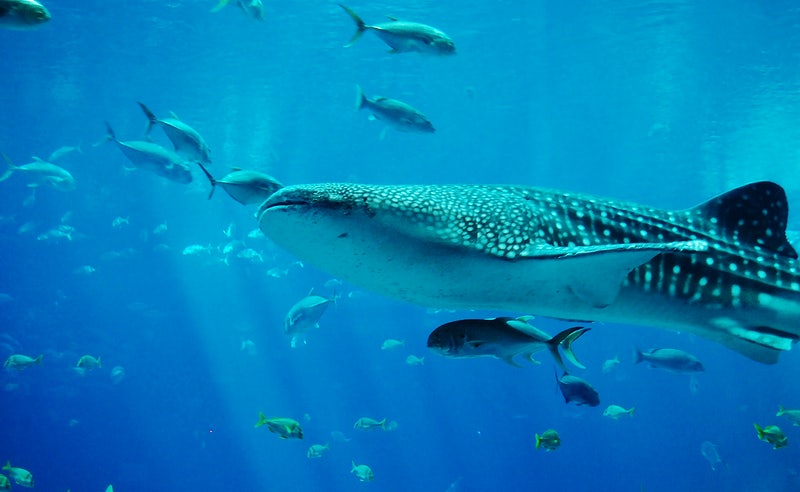There are thousand-plus sharks wandering the waters of the world. While there is a wide variety of animals either laying eggs or giving birth to their offspring, the case of sharks may be a little different.
With the wide variety of species of sharks, it is no shock that there must be a huge variety of reproduction and birth methods in these powerful creatures. To give you an idea, we’ll be looking at how sharks reproduce and whether sharks mate or lay eggs.
In the majority of animals, an offspring is born either through the mother laying an egg or giving birth to the offspring. Most do not have other methods of reproduction and use one of the approaches stated above.
Sharks, however, have a similar but unique reproduction method. While there are some species of egg-laying sharks, most of them give birth to young sharks. Let’s look at this in detail.
Birth of a shark offspring
Oviparous (one who lays eggs) sharks are in the minority, with some species being Australian Swellshark, Dogfish Shark, Carpet Shark, Port Jackson Shark, Cat Shark, and Zebra Shark. The most common phenomenon that occurs, however, is the one in which sharks produce eggs in their bodies but do not lay them. This is called ovoviviparity. These eggs hatch in the body of the female and are born as miniature adult sharks.
The largest species of sharks, called Whale sharks, are also ovoviviparous. Some of the other species of sharks that are ovoviviparous are Thresher Sharks, Mako Sharks, Nurse Sharks, Great White Sharks, and Sand Tiger Sharks. In 1996, a “megamamma” Whale Shark was seen to be carrying about 300 embryos that were ready to be released into the ocean. So, as we have seen, sharks may be viviparous, oviparous, or ovoviviparous. Let’s explore these birth processes in detail.
Viviparity in sharks
In those sharks that are viviparous, the female shark produces the eggs in her body. Once they complete the duration of being nourished in the egg, they are hatched while still being inside the female body. The babies of viviparous sharks are fed through a placenta, present between the pectoral fins. The placenta is connected by the umbilical cord to the body of the mother, and the babies receive nourishment in the placenta through the umbilical cord.
The placenta is the basic organ for providing nourishment to the babies when they are still in the body of the mother. These live young sharks are then released into the ocean by the mother. In one litter, a viviparous mother can produce up to twenty or more babies. The babies are then developed enough to endure on their own in the water.
Oviparity in sharks
Oviparity is one of the common reproduction methods in animals. Oviparous animals lay their eggs once they are developed enough. The sharks use the oviparity method to reproduce and deposit eggs in the ocean. These eggs, if not eaten by a predator, will hatch when the babies are developed enough.
The eggs laid by oviparous sharks are not guarded by either parent and are covered by a thick membrane. The eggs laid by oviparous sharks are also recognized as “mermaid’s purses” or “devil’s purses.”
Just like a chicken egg, the mermaid’s purse has a yolk that feeds the embryo present in the egg. Some of these have tendrils present outside of them that attach the egg to somewhere on the seabed. In this way, the eggs of oviparous sharks are often kept safe. Zebra sharks, Horn Shark, and Swellshark are oviparous and lay eggs with the thick membrane mentioned above. These eggs hatch once fully developed.
Ovoviviparity in Sharks (also known as Aplacental Viviparity)
Ovoviviparity is kind of similar to viviparity, except that there is no placenta. The eggs are produced inside the body of the female and are also hatched while still in the body of the mother. However, there is no placenta present to nourish the babies in the mother’s body. These babies survive on unfertilized eggs. They also eat other babies present in the body of the mother, making them oviphagous.
The eggs are hatched inside the body of the shark for about two years. During these times, the babies also develop teeth. Some of the babies who develop teeth earlier survive in the body of the mother by eating their siblings. This is called intrauterine cannibalism. Some developed babies feed off the yolk of other eggs. This is known as oophagy.
Moreover, some of the other methods of nutrition for the young are fluids secreted by the mother. When they are completely developed, they are released into the ocean by means of contractions.
While fertilization is always internal in sharks by means of copulation, the birth of the young may differ, as we have seen above. The “claspers”, which are the extensions of the pelvic fins of the male shark, are used to transfer the sperm into the body of the female in order to fertilize the eggs.
Conclusion
The reproductive biology of the elasmobranchs is fascinating. Shark babies are born fully independent with no need for the mother to nurse them. Studying the process of procreation in all species is complex, but sharks are definitely ones at the top of the list with their complex reproduction methods.







